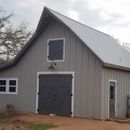Workshop Attic Temperature Question
Hello All,
My workshop is a free-standing 22′ x 28′ building, in the style of a Tobacco Barn, with a standing seam metal roof (see photo – front faces north). I’m a hobbyist woodworker and my shop is downstairs, but I would like to use the attic to store items that can take heat and cold without damage. That said, I would like to drop 15-20 degrees off my daytime high. Currently, the attic is topping out around 125 degrees, as measured at 6’ from the attic floor when the ambient temperature is in the mid-to-high 90s. I’m located in Fredericksburg Texas, which is about the same latitude as Austin, but it tends to be 5-10 degrees cooler due to elevation.
Building Situation:
The ground floor walls have batt insulation and is sheet rocked. There are no penetrations in the ground floor ceiling, save for a set of pull-down attic stairs. Attic floor bays are insulated with fiberglass. The attic is built with an attic truss (and is floored in the 9.5’ x 22’ middle section. The sections on either side are not floored – yet, though I will probably floor some of it for light storage. The roof is metal with OSB decking. The attic has soffit vents, but no ridge vent. The ground floor is normally left unconditioned and is only heated (space heaters) or cooled occasionally (small window A/C unit in east wall). Over the past three winters the shop area has never dropped below freezing, despite overnight lows in the low teens each winter, and in the hot summer it is still tolerable most of the time. I added the last part to say that the building is pretty well insulated.
Specific Question(s):
I would like to know what my options are for “insulating” the attic from the heat radiating in and down from the roof assembly.
• Cut gable vents near the ridge to vent the heat (maybe closeable for winter)? Installing a ridge vent is out of the question at this point. Would the course of action cause moisture problems? It also seems that adding gable vents will cause an updraft when the attic stairs are pulled down.
• Is there a creative way to use rigid foam on the underside of the rafters to create less radiant surface? If I did would I need to close up the soffit vents?
• Lastly, should I seal the soffit vents up and insulate the h*ll out of the attic ceiling against the deck? If so, should I remove the attic floor insulation?
• Any other ideas?
Thank you in advance for your thoughts and wisdom,
Steve L.
GBA Detail Library
A collection of one thousand construction details organized by climate and house part










Replies
You state that there is no ridge vent, then talk about putting gable vents near the ridge vent, which seems inconsistent. (It's a bit hard to tell from the picture.) I'm assuming you have just the soffit vents, no ridge vents.
Rigid foam in an attic used for storage requires some sort of ignition barrier to be code-legal and reasonably fire-safe.
Painting the under side of the OSB with a "radiant barrier paint" ( something silvery, not some magic-mouse-milk-with-nano-sphere-additive paint scam) and PERFORATED aluminized fabric type radiant barrier on the underside of the rafters all the way down to the soffits will take a fair amount of the peak temperatures in the attic, without disturbing the wintertime performance. The perforated radiant barriers do not create a moisture trap- they run about 5 perms, which should allow both the attic and the roof deck to dry. While not quite as low-E as a true radiant barrier the paint on stuff is way better than nothing, and in combination with the aluminized fabric RB it'll make a real difference, better that than the RB alone.
If either or both of gable ends gets direct sunlight in summer, insulating them with fiber insulation is worthwhile.
Hello Dana - thank you for your response.
Sorry it that I was not clear concerning a ridge vent - there is no ridge vent. I was proposing installing a gable vent near the ridge to vent from a high location.
I did a search for the aluminized perforated radiant barrier fabric that you mentioned - the Heavy Duty Reflectix brand comes in 48 x 125 ft rolls.and states that is blocks 94+% of radiant heat. This is available at Home Depot. In your opinion, is there a brand that is better suited or more durable?
As for Radiant Barrier Paint - I see that Sherwin Williams makes an E-Barrier paint "with microscopic reflective particles."
Any thoughts on the above? Thank you again.
Steven L.
The perforated fabric radiant barriers are all pretty similar (I don't have direct experience with more than a couple brands, and couldn't tell you at this point which brands they were.) You can probably beat box store pricing buying online.
https://www.radiantguard.com/pages/perforated-radiant-barrier
http://www.atticfoil.com/index.php/products/
http://www.energyefficientsolutions.com/ARMAFOIL.asp
http://www.ecofoil.com/All-Products/Radiant-Barrier-Perforated?gclid=EAIaIQobChMI-t7r84y51QIVkYSzCh1syglSEAAYASAAEgL_tPD_BwE
I'm not sure how well S-W E-Barrier stacks up against the competition but it's the right kind of stuff. If that's the most readily available, go for it. Solec Solar's LoMit-II Max seems to have a good following, and decent specs. The radiant barrier folks all look down their noses at low-E paint, but list at least some apples-to-apples comparisons of those paints even while deriding them as "...not a real radiant barrier..."
http://www.rimainternational.org/index.php/technical/ircc/
https://www.radiantguard.com/pages/radiant-barrier-paint
The paint doesn't have to be super high performance as a radiant barrier- it's a heluva lot higher performance than unpainted OSB facing the ooh-shiineyyy "real" radiant barrier. You might try just painting the roof deck & rafters with the low-E paint first, and defer the radiant barrier to see if it meets your goals, but the combination is measurably better than either the paint or RB alone.